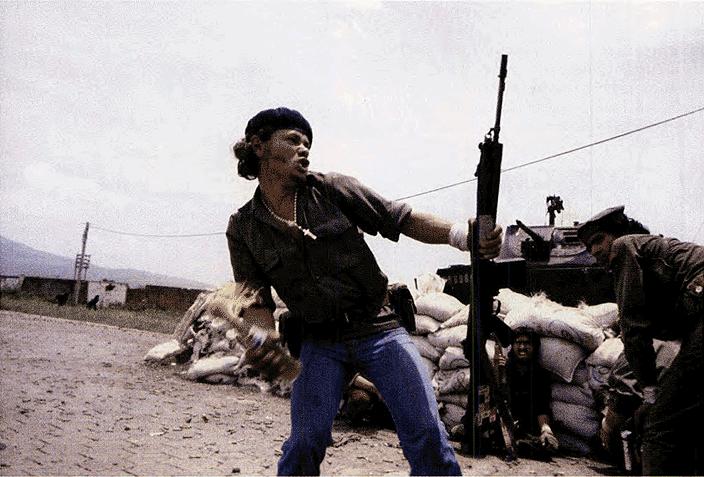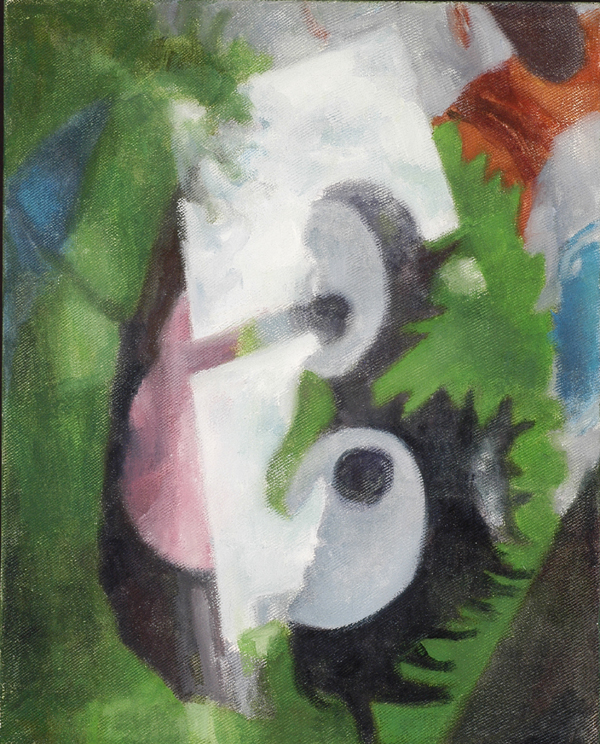Posted by Richard Rothstein on April 22nd, 2007
EXODUS 20:2-14: “You shall have no other gods before me. You shall not make for yourself an image, whether in the form of anything that is in heaven above, or that is on the earth beneath, or that is in the water under the earth. You shall not bow down to them or worship them; for I the Lord your God am a jealous God, punishing children for the iniquity of parents, to the third and the fourth generation of those who reject me, but showing steadfast love to the thousandth generation of those who love me and keep my commandments.

I’m fascinated by the relationship between secular and religious iconography. In particular, I have an intensely passionate emotional and intellectual relationship with one of the world’s most compelling and famous secular icons: the Empire State Building and it is through that passion that I’ve come to understand something more about religious iconography.
When it comes to religious iconography I am seriously handicapped as an agnostic, a cynic and as a Jew. This subject is particularly challenging for a Jew, secular or otherwise. Even a secular Jew grows up “understanding” that iconography is simple-minded at best, blasphemous at worst. The truth is found within our hearts and minds and to seek the truth through images is false, intellectually lazy and in opposition to the absolute word of God.
But my life long relationship with the Empire State Building has defied my Jewish perspective and seditiously lured me into the world of image worship. (Just one of the commandments I routinely break.) more… »
Posted by Sunil Gangadharan on April 19th, 2007
Harpers is one of my favorite magazines and a couple of months back I had the good fortune to run into some writing that resonated with the way I approach ideas for my paintings. The case concerns artist Joy Garnett of the ‘Molotov Man‘ fame. She is an artist who uses ‘found’ online imagery in the creation of her art and knowingly subverts photographs and images found on the web to suit the message that she would like to propound in her paintings. In her own words..
“I searched the web for images of figures in extreme emotional or physical states. I saved the most promising images in folders on my computer desktop, and I let them sit for a while so I could forget where I found them. I wanted my choices to be based more on aesthetic criteria than on my emotional attachment to their narratives. Eventually I would look through the folders again to see what struck me…”
To make a long story short, she was initially told by a lawyer representing the author of an image she used (Susan Meiselas shot one of the iconic images that Joy Garnett later painted) to secure permission before using the image. Naturally, Joy did not think it necessary to go through these motions as she had created ‘original’ artwork using the image as a springboard… and posted her predicament to Rhizome.org. The bloggers on Rhizome ran with it and produced hundreds of subversions of the original image challenging the lawyer to prosecute all of them.. The lawyers withdrew on seeing the shaky nature of their case in prosecuting Joy Garnett. You can read multiple points of view in two essays from Harpers hyperlinked at the bottom of this post…
 Susan Meiselas “untitled” 1979 Color photograph
Susan Meiselas “untitled” 1979 Color photograph
 Joy Garnett “Molotov” 2003 Oil on canvas 70 x 60 inches
Joy Garnett “Molotov” 2003 Oil on canvas 70 x 60 inches
My technique is to paint from photographs. Every once in a while when I explore an idea, I tend to go to the web and download compelling images from the web to act as a spark that will lead to the creation of a painting. In my view I am engaging in a dialogue with art that already exists out there and in the eventual subversion of the original image in my painting, I am merely enriching existing art. I sometimes acknowledge the source and sometimes bother not to (especially if I do not find it on the web – I do not go crazy trying to find the source)… I do not regard this as plagiarism, but some people do…
How many times have you directly used images from the web in the creation of your art? How many times have you used web based images indirectly (as a spark generator and incubator) for an idea that you then use to create your art? If the former case is dubbed plagiarism by some people, then the latter case also should be… What are your views?
Like someone said, the cross pollination and extension of existing ideas is critical to human creativity, be it art science or commerce.
References:
On the rights of the Molotov Man – article by Joy G. and Susan M. in Harpers
The ecstasy of influence – an invigorating essay by Jonathan Lethem
Posted by Leslie Holt on April 18th, 2007

Steve’s previous post made me think about mystery and ambiguity in art, particularly as they help to create meaning. And his image reminded me of this recent image I made as part of my “Unholy Gost” series. I use ambiguous spaces and images in this series of paintings.
I talk to my students about the difference between “deliberate ambiguity” and disorganized confusion. While I encourage the happy accidents that occur in the process of creation, it can sometimes be an excuse to leave a piece unfinished, unclear and incoherent. Beginning students often want to make images that deal with the idea of chaos, but end up making disorganized messes. Mysterious images can so easily be so ambiguous as to be unreadable with no entry way into the work.
These can be pitfalls of art making. How can you tell if ambiguity is purposeful or if it reflects lack of clarity on the artist’s part?
Have you explored ambiguity in your own work? What are the challenges you face when doing so? Do you have any favorite artists who use ambiguity successfully?
PS – I tried to make the image larger, I swear, and the best I could do was a thumbnail you can enlarge. Anyone can go in and fix it if they are so inclined. I apologize for my ineptitude.
Posted by Doug Plummer on April 17th, 2007
 I had a very successful Photo Lucida with my contra dance project. The consensus after 4 days of reviews, with some of the top people in the photography fine-art field, is that the project has legs and great potential. Now I need to name it.
I had a very successful Photo Lucida with my contra dance project. The consensus after 4 days of reviews, with some of the top people in the photography fine-art field, is that the project has legs and great potential. Now I need to name it.
Alec Soth has a post today on book titles. He loves pondering them, feels they define and sum up the nature of a work, and that they can make or break the success of a book.
I am considerably less gifted in this realm, despite my usual felicity with words. I am struggling to come up with an all-encompassing, pithy and memorable title for my contra dance project.
“Contra Dance in America: A Photographic Journey” is accurate, but really boring. My other working title, “Unconfined Joy,” is from the over-quoted Lord Byron poem, which goes,
On with the dance! let joy be unconfined;
No sleep till morn, when Youth and Pleasure meet
To chase the glowing hours with flying feet.
~George Gordon, Lord Byron, Childe Harold’s Pilgrimage
Any ideas out there? Here’s the link to my “yes-it-really-needs-updating” dance page. You can also look through the blog posts from Photo Lucida.
Posted by Steve Durbin on April 17th, 2007
Ansel Adams was known for his skill in capturing monumental landscapes in massive detail. But he was well aware that sharpness for its own sake is sterile: “There is nothing worse than a sharp image of a fuzzy concept.” What would he think of this fuzzy image of a fuzzy concept?


Though this photograph appears blurred, the camera was actually quite well focused on the subject. Which was my shadow cast by the rising sun on the off-white wall of the hallway outside my office. Not period.
Despite the blur, this image may beat any of my others in conceptual edge, at least according to some who shall remain nameless. At the same time, it seems to fit my recent protestation of edgelessness (see comment 52 of last week’s post). I swear that the image, the poem(??), and the Adams quote were entirely unacquainted with each other in my conscious mind before I started writing this post. Nor, until this very moment, had any of them met William Henry Fox Talbot’s (love the names!) description of his 1839 photographic invention as “the art of fixing a shadow.” Photography and writing are sometimes parallel paths of discovery.
Posted by Karl Zipser on April 16th, 2007

Painting
From Life vs.
From Photos
Who are the great, the truly great artists of our times? — let’s say, artists active in the period 1975 to 2000.
I realize that some might say that it is too early to judge. If this is your opinion, I’d like to ask a parallel question: who are the artists active prior to 1975-2000 who came to be recognized as great during that period?
Also, let’s not confuse ‘great’ with ‘important.’ Andy Warhol, was undoubtedly an important artist, but a great one? I don’t know — maybe you do!
Posted by Richard Rothstein on April 15th, 2007

From today’s New York Times “Digital manipulation is just another tool. It’s less profound than the lens you use, or the angle. But in the end, photography is all about manipulation, and as it’s evolved, it’s become more manipulative in every way. I’ve never seen photography as a truthful medium. It’s about individual perceptions of reality, and that’s what people want to see.”
The Times examines the work of London photographer, Nick Knight. “When I’m producing a piece of work,” Knight says, “I’m looking for something I haven’t seen before, and once I’ve produced it, I’ll want to see something else.”
One of the world’s most successful fashion photographers, Knight lives in the digital world.
I realized that one of the most fascinating and potentially controversial and engaging aspects of digitally enhanced photography is that unlike any other visual art form before it, just about anyone with a computer can have at it. A great artist’s work (assuming you accept Knight as a great artist) becomes an interactive experience that can evolve, devolve and easily change according to the viewer’s own vision. Imagine a visual art form that is a photograph or creation that is the combined effort and vision of both the artist and the viewer(s). Warhol’s multiple images reimagined except the series is the work of the original artist digitally “enhanced” infinitely by his viewers. more… »


 I had a very successful
I had a very successful 

